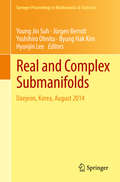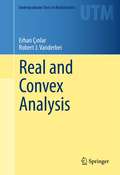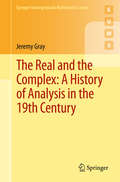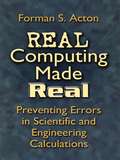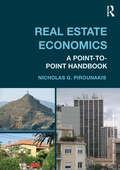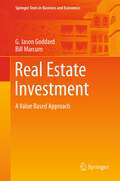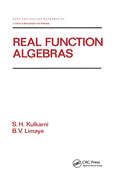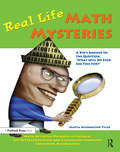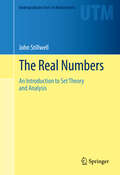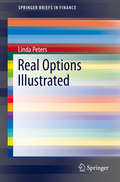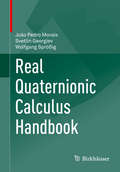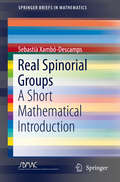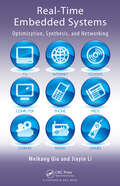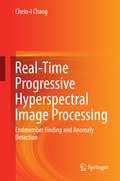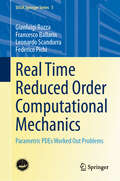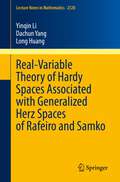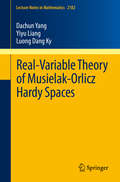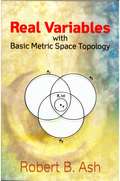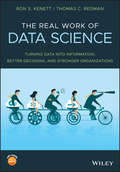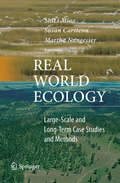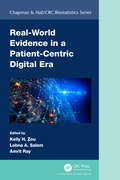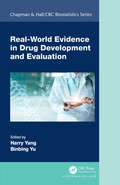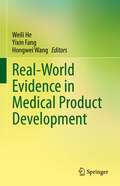- Table View
- List View
Real and Complex Submanifolds
by Young Jin Suh Jürgen Berndt Yoshihiro Ohnita Byung Hak Kim Hyunjin LeeEdited in collaboration with the Grassmann Research Group, this book contains many important articles delivered at the ICM 2014 Satellite Conference and the 18th International Workshop on Real and Complex Submanifolds, which was held at the National Institute for Mathematical Sciences, Daejeon, Republic of Korea, August 10-12, 2014. The book covers various aspects of differential geometry focused on submanifolds, symmetric spaces, Riemannian and Lorentzian manifolds, and Kähler and Grassmann manifolds.
Real and Convex Analysis
by Robert J Vanderbei Erhan ÇınlarThis book offers a first course in analysis for scientists and engineers. It can be used at the advanced undergraduate level or as part of the curriculum in a graduate program. The book is built around metric spaces. In the first three chapters, the authors lay the foundational material and cover the all-important "four-C's": convergence, completeness, compactness, and continuity. In subsequent chapters, the basic tools of analysis are used to give brief introductions to differential and integral equations, convex analysis, and measure theory. The treatment is modern and aesthetically pleasing. It lays the groundwork for the needs of classical fields as well as the important new fields of optimization and probability theory.
The Real and the Complex: A History of Analysis in the 19th Century
by Jeremy GrayThis book contains a history of real and complex analysis in the nineteenth century, from the work of Lagrange and Fourier to the origins of set theory and the modern foundations of analysis. It studies the works of many contributors including Gauss, Cauchy, Riemann, and Weierstrass. This book is unique owing to the treatment of real and complex analysis as overlapping, inter-related subjects, in keeping with how they were seen at the time. It is suitable as a course in the history of mathematics for students who have studied an introductory course in analysis, and will enrich any course in undergraduate real or complex analysis.
Real Computing Made Real: Preventing Errors in Scientific and Engineering Calculations
by Forman S. ActonEngineers and scientists who want to avoid insidious errors in their computer-assisted calculations will welcome this concise guide to trouble-shooting. Real Computing Made Real offers practical advice on detecting and removing bugs. It also outlines techniques for preserving significant figures, avoiding extraneous solutions, and finding efficient iterative processes for solving nonlinear equations.Those who compute with real numbers (for example, floating-point numbers stored with limited precision) tend to develop techniques that increase the frequency of useful answers. But although there might be ample guidance for those addressing linear problems, little help awaits those negotiating the nonlinear world. This book, geared toward upper-level undergraduates and graduate students, helps rectify that imbalance. Its examples and exercises (with answers) help readers develop problem-formulating skills and assist them in avoiding the common pitfalls that software packages seldom detect. Some experience with standard numerical methods is assumed, but beginners will find this volume a highly practical introduction, particularly in its treatment of often-overlooked topics.
Real Estate Economics: A Point-to-Point Handbook (Routledge Advanced Texts in Economics and Finance)
by Nicholas G. PirounakisReal Estate Economics: A point-to-point handbook introduces the main tools and concepts of real estate (RE) economics. It covers areas such as the relation between RE and the macro-economy, RE finance, investment appraisal, taxation, demand and supply, development, market dynamics and price bubbles, and price estimation. It balances housing economics with commercial property economics, and pays particular attention to the issue of property dynamics and bubbles – something very topical in the aftermath of the US house-price collapse that precipitated the global crisis of 2008. This textbook takes an international approach and introduces the student to the necessary ‘toolbox’ of models required in order to properly understand the mechanics of real estate. It combines theory, technique, real-life cases, and practical examples, so that in the end the student is able to: • read and understand most RE papers published in peer-reviewed journals; • make sense of the RE market (or markets); and • contribute positively to the preparation of economic analyses of RE assets and markets soon after joining any company or other organization involved in RE investing, appraisal, management, policy, or research. This book should be particularly useful to third-year students of economics who may take up RE or urban economics as an optional course, to postgraduate economics students who want to specialize in RE economics, to graduates in management, business administration, civil engineering, planning, and law who are interested in RE, as well as to RE practitioners and to students reading for RE-related professional qualifications.
Real Estate Investment: A Value Based Approach
by G Jason Goddard Bill MarcumThis book fills a gap in the existing resources available to students and professionals requiring an academically rigorous, but practically orientated source of knowledge about real estate finance. Written by a bank vice-president who for many years has practiced as a commercial lender and who teaches real estate investment at university level, and an academic whose area of study is finance and particularly valuation, this book will lead readers to truly understand the fundamentals of making a sound real estate investment decision. The focus is primarily on the valuation of leased properties such as apartment buildings, office buildings, retail centers, and warehouse space, rather than on owner occupied residential property.
Real Estate Modelling and Forecasting
by Chris Brooks Sotiris TsolacosAs real estate forms a significant part of the asset portfolios of most investors and lenders, it is crucial that analysts and institutions employ sound techniques for modelling and forecasting the performance of real estate assets. Assuming only a basic understanding of econometrics, this book introduces and explains a broad range of quantitative techniques that are relevant for the analysis of real estate data. It includes numerous detailed examples, giving readers the confidence they need to estimate and interpret their own models. Throughout, the book emphasises how various statistical techniques may be used for forecasting and shows how forecasts can be evaluated. Written by a highly experienced teacher of econometrics and a senior real estate professional, both of whom are widely known for their research, Real Estate Modelling and Forecasting is the first book to provide a practical introduction to the econometric analysis of real estate for students and practitioners.
Real Function Algebras
by S.H. Kulkarni B.V. LimayeThis self-contained reference/text presents a thorough account of the theory of real function algebras. Employing the intrinsic approach, avoiding the complexification technique, and generalizing the theory of complex function algebras, this single-source volume includes: an introduction to real Banach algebras; various generalizations of the Stone-Weierstrass theorem; Gleason parts; Choquet and Shilov boundaries; isometries of real function algebras; extensive references; and a detailed bibliography.;Real Function Algebras offers results of independent interest such as: topological conditions for the commutativity of a real or complex Banach algebra; Ransford's short elementary proof of the Bishop-Stone-Weierstrass theorem; the implication of the analyticity or antianalyticity of f from the harmonicity of Re f, Re f(2), Re f(3), and Re f(4); and the positivity of the real part of a linear functional on a subspace of C(X).;With over 600 display equations, this reference is for mathematical analysts; pure, applied, and industrial mathematicians; and theoretical physicists; and a text for courses in Banach algebras and function algebras.
Real Life Math Mysteries: A Kid's Answer to the Question, "What Will We Ever Use This For?" (Grades 4-10)
by Marya Washington TylerZookeeper, horse stable owner, archaeologist, lawyer, pilot, fireman, newspaper editor, dairy farmer, arson detective . . . these are just a few of the real people who, in their own words, share their own daily encounters with mathematics. How much lettuce does the Pizza Hut manager need to order for next week? How many rose bushes can a gardener fit around a wading pool? How many fire hoses will be needed to extinguish the fire? Your students will be amazed at the real-life math faced by truck drivers, disc jockeys, farmers, and car mechanics.Real Life Math Mysteries introduces students to math in the real world through a series of problems drawn from a vast array of community leaders, business professionals, and city officials. The problems are designed to stimulate students' creative thinking and teach the value of math in a real-world setting.Each concise and clear problem is provided on a blackline master and includes problem-solving suggestions for students with a comprehensive answer key. The problems are tied to the guidelines for math instruction from the National Council of Teachers of Mathematics. This book will get students thinking about the mathematics all around them.Make math last a lifetime. Students will delight in the real-life approach to math as they realize that they will use math skills over and over again in whatever vocation they choose. Make math an exciting experience that children realize will last a lifetime.More books that make math fun for students include Extreme Math, It's Alive!, and It's Alive! And Kicking!.Grades 4-10
The Real Numbers
by John StillwellWhile most texts on real analysis are content to assume the real numbers, or to treat them only briefly, this text makes a serious study of the real number system and the issues it brings to light. Analysis needs the real numbers to model the line, and to support the concepts of continuity and measure. But these seemingly simple requirements lead to deep issues of set theory--uncountability, the axiom of choice, and large cardinals. In fact, virtually all the concepts of infinite set theory are needed for a proper understanding of the real numbers, and hence of analysis itself. By focusing on the set-theoretic aspects of analysis, this text makes the best of two worlds: it combines a down-to-earth introduction to set theory with an exposition of the essence of analysis--the study of infinite processes on the real numbers. It is intended for senior undergraduates, but it will also be attractive to graduate students and professional mathematicians who, until now, have been content to "assume" the real numbers. Its prerequisites are calculus and basic mathematics. Mathematical history is woven into the text, explaining how the concepts of real number and infinity developed to meet the needs of analysis from ancient times to the late twentieth century. This rich presentation of history, along with a background of proofs, examples, exercises, and explanatory remarks, will help motivate the reader. The material covered includes classic topics from both set theory and real analysis courses, such as countable and uncountable sets, countable ordinals, the continuum problem, the Cantor-Schröder-Bernstein theorem, continuous functions, uniform convergence, Zorn's lemma, Borel sets, Baire functions, Lebesgue measure, and Riemann integrable functions.
Real Options Illustrated
by Linda PetersThis book explains the standard Real Options Analysis (ROA) literature in a straightforward, step by step manner without the use of complex mathematics. A lot of ROA literature is described through partial differential equations, probabilitydensity functions and simulation techniques, all of which may be unconvincing in the applicable qualities ROA possesses. Using this book, the reader will have a better grasp about how ROA works and will be able to provide his or her judgment about ROA, since all the basics, as well as its positive and negative qualities, are discussed. Real Options Illustrated provides practitioners with a real options framework and encourages readers to study the methodology using the in-depth explanations. This introduction to ROA is sufficient to equip readers with ROA basics, enabling them to perform future independent research. From this book, readers can judge whether ROA is of any value to their field.
Real Quaternionic Calculus Handbook
by João Pedro Morais Svetlin Georgiev Wolfgang SprößigReal quaternion analysis is a multi-faceted subject. Created to describe phenomena in special relativity, electrodynamics, spin etc. , it has developed into a body of material that interacts with many branches of mathematics, such as complex analysis, harmonic analysis, differential geometry, and differential equations. It is also a ubiquitous factor in the description and elucidation of problems in mathematical physics. In the meantime real quaternion analysis has become a well established branch in mathematics and has been greatly successful in many different directions. This book is based on concrete examples and exercises rather than general theorems, thus making it suitable for an introductory one- or two-semester undergraduate course on some of the major aspects of real quaternion analysis in exercises. Alternatively, it may be used for beginning graduate level courses and as a reference work. With exercises at the end of each chapter and its straightforward writing style the book addresses readers who have no prior knowledge on this subject but have a basic background in graduate mathematics courses, such as real and complex analysis, ordinary differential equations, partial differential equations, and theory of distributions.
Real Spinorial Groups: A Short Mathematical Introduction (SpringerBriefs in Mathematics)
by Sebastià Xambó-DescampsThis book explores the Lipschitz spinorial groups (versor, pinor, spinor and rotor groups) of a real non-degenerate orthogonal geometry (or orthogonal geometry, for short) and how they relate to the group of isometries of that geometry.After a concise mathematical introduction, it offers an axiomatic presentation of the geometric algebra of an orthogonal geometry. Once it has established the language of geometric algebra (linear grading of the algebra; geometric, exterior and interior products; involutions), it defines the spinorial groups, demonstrates their relation to the isometry groups, and illustrates their suppleness (geometric covariance) with a variety of examples. Lastly, the book provides pointers to major applications, an extensive bibliography and an alphabetic index.Combining the characteristics of a self-contained research monograph and a state-of-the-art survey, this book is a valuable foundation reference resource on applications for both undergraduate and graduate students.
Real-Time Embedded Systems: Optimization, Synthesis, and Networking
by Meikang Qiu Jiayin LiUbiquitous in today's consumer-driven society, embedded systems use microprocessors that are hidden in our everyday products and designed to perform specific tasks. Effective use of these embedded systems requires engineers to be proficient in all phases of this effort, from planning, design, and analysis to manufacturing and marketing.Taking a sys
Real-Time Progressive Hyperspectral Image Processing
by Chein-I ChangThe book covers the most crucial parts of real-time hyperspectral image processing: causality and real-time capability. Recently, two new concepts of real time hyperspectral image processing, Progressive HyperSpectral Imaging (PHSI) and Recursive HyperSpectral Imaging (RHSI). Both of these can be used to design algorithms and also form an integral part of real time hyperpsectral image processing. This book focuses on progressive nature in algorithms on their real-time and causal processing implementation in two major applications, endmember finding and anomaly detection, both of which are fundamental tasks in hyperspectral imaging but generally not encountered in multispectral imaging. This book is written to particularly address PHSI in real time processing, while a book, Recursive Hyperspectral Sample and Band Processing: Algorithm Architecture and Implementation (Springer 2016) can be considered as its companion book.
Real Time Reduced Order Computational Mechanics: Parametric PDEs Worked Out Problems (SISSA Springer Series #5)
by Gianluigi Rozza Francesco Ballarin Leonardo Scandurra Federico PichiThe book is made up by several worked out problems concerning the application of reduced order modeling to different parametric partial differential equations problems with an increasing degree of complexity.This work is based on some experience acquired during lectures and exercises in classes taught at SISSA Mathematics Area in the Doctoral Programme “Mathematical Analysis, Modelling and Applications”, especially in computational mechanics classes, as well as regular courses previously taught at EPF Lausanne and during several summer and winter schools. The book is a companion for master and doctoral degree classes by allowing to go more deeply inside some partial differential equations worked out problems, examples and even exercises, but it is also addressed for researchers who are newcomers in computational mechanics with reduced order modeling. In order to discuss computational results for the worked out problems presented in this booklet, we will rely on the RBniCS Project. The RBniCS Project contains an implementation in FEniCS of the reduced order modeling techniques (such as certified reduced basis method and Proper Orthogonal Decomposition-Galerkin methods) for parametric problems that will be introduced in this booklet.
Real-Variable Theory of Hardy Spaces Associated with Generalized Herz Spaces of Rafeiro and Samko (Lecture Notes in Mathematics #2320)
by Dachun Yang Yinqin Li Long HuangThe real-variable theory of function spaces has always been at the core of harmonic analysis. In particular, the real-variable theory of the Hardy space is a fundamental tool of harmonic analysis, with applications and connections to complex analysis, partial differential equations, and functional analysis.This book is devoted to exploring properties of generalized Herz spaces and establishing a complete real-variable theory of Hardy spaces associated with local and global generalized Herz spaces via a totally fresh perspective. This means that the authors view these generalized Herz spaces as special cases of ball quasi-Banach function spaces.In this book, the authors first give some basic properties of generalized Herz spaces and obtain the boundedness and the compactness characterizations of commutators on them. Then the authors introduce the associated Herz–Hardy spaces, localized Herz–Hardy spaces, and weak Herz–Hardy spaces, and develop a complete real-variable theory of these Herz–Hardy spaces, including their various maximal function, atomic, molecular as well as various Littlewood–Paley function characterizations. As applications, the authors establish the boundedness of some important operators arising from harmonic analysis on these Herz–Hardy spaces. Finally, the inhomogeneous Herz–Hardy spaces and their complete real-variable theory are also investigated.With the fresh perspective and the improved conclusions on the real-variable theory of Hardy spaces associated with ball quasi-Banach function spaces, all the obtained results of this book are new and their related exponents are sharp. This book will be appealing to researchers and graduate students who are interested in function spaces and their applications.
Real-Variable Theory of Musielak-Orlicz Hardy Spaces
by Dachun Yang Yiyu Liang Luong Dang KyThe main purpose of this book is to give a detailed and complete survey of recent progress related to the real-variable theory of Musielak-Orlicz Hardy-type function spaces, and to lay the foundations for further applications. The real-variable theory of function spaces has always been at the core of harmonic analysis. Recently, motivated by certain questions in analysis, some more general Musielak-Orlicz Hardy-type function spaces were introduced. These spaces are defined via growth functions which may vary in both the spatial variable and the growth variable. By selecting special growth functions, the resulting spaces may have subtler and finer structures, which are necessary in order to solve various endpoint or sharp problems. This book is written for graduate students and researchers interested in function spaces and, in particular, Hardy-type spaces.
Real Variables: with Basic Metric Space Topology
by Prof. Robert B. AshDesigned for a first course in real variables, this text presents the fundamentals for more advanced mathematical work, particularly in the areas of complex variables, measure theory, differential equations, functional analysis, and probability. Geared toward advanced undergraduate and graduate students of mathematics, it is also appropriate for students of engineering, physics, and economics who seek an understanding of real analysis.The author encourages an intuitive approach to problem solving and offers concrete examples, diagrams, and geometric or physical interpretations of results. Detailed solutions to the problems appear within the text, making this volume ideal for independent study. Topics include metric spaces, Euclidean spaces and their basic topological properties, sequences and series of real numbers, continuous functions, differentiation, Riemann-Stieltjes integration, and uniform convergence and applications.
Real Variables (Pure And Applied Mathematics Ser. #Volume 123)
by Alberto TorchinskyA modern introduction to the theory of real variables and its applications to all areas of analysis and partial differential equations. The book discusses the foundations of analysis, including the theory of integration, the Lebesque and abstract integrals, the Radon-Nikodym Theorem, the Theory of Banach and Hilbert spaces, and a glimpse of Fourier series. All material is presented in a clear and motivational fashion.
The Real Work of Data Science: Turning data into information, better decisions, and stronger organizations
by Ron S. Kenett Thomas C. RedmanThe essential guide for data scientists and for leaders who must get more from their data science teams The Economist boldly claims that data are now "the world's most valuable resource." But, as Kenett and Redman so richly describe, unlocking that value requires far more than technical excellence. The Real Work of Data Science explores understanding the problems, dealing with quality issues, building trust with decision makers, putting data science teams in the right organizational spots, and helping companies become data-driven. This is the work that spells the difference between a good data scientist and a great one, between a team that makes marginal contributions and one that drives the business, between a company that gains some value from its data and one in which data truly is "the most valuable resource." "These two authors are world-class experts on analytics, data management, and data quality; they've forgotten more about these topics than most of us will ever know. Their book is pragmatic, understandable, and focused on what really counts. If you want to do data science in any capacity, you need to read it."—Thomas H. Davenport, Distinguished Professor, Babson College and Fellow, MIT Initiative on the Digital Economy "I like your book. The chapters address problems that have faced statisticians for generations, updated to reflect today's issues, such as computational Big Data."—Sir David Cox, Warden of Nuffield College and Professor of Statistics, Oxford University "Data science is critical for competitiveness, for good government, for correct decisions. But what is data science? Kenett and Redman give, by far, the best introduction to the subject I have seen anywhere. They address the critical questions of formulating the right problem, collecting the right data, doing the right analyses, making the right decisions, and measuring the actual impact of the decisions. This book should become required reading in statistics and computer science departments, business schools, analytics institutes and, most importantly, by all business managers." —A. Blanton Godfrey, Joseph D. Moore Distinguished University Professor, Wilson College of Textiles, North Carolina State University
Real World Ecology
by Susan Carstenn Martha Nungesser Shili MiaoEcological and environmental research has increased in scope and complexity in the last few decades, from simple systems with a few managed variables to complex ecosystems with many uncontrolled variables. These issues encompass problems that are inadequately addressed using the types of carefully controlled experiments that dominate past ecological research. Contemporary challenges facing ecologists include whole ecosystem responses to planned restoration activities and ecosystem modifications, as well as unplanned catastrophic events such as biological invasions, natural disasters, and global climate changes. Major perturbations implicated in large-scale ecological alterations share important characteristics that challenge traditional experimental design and statistical analyses. These include: * Lack of randomization, replication and independence * Multiple scales of spatial and temporal variability * Complex interactions and system feedbacks. In real world ecology, standard replicated designs are often neither practical nor feasible for large-scale experiments, yet ecologists continue to cling to these same standard designs and related statistical analyses. Case studies that fully elucidate the currently available techniques for conducting large-scale unreplicated analyses are lacking. Real World Ecology: Large-Scale and Long-Term Case Studies and Methods is the first to focus on case studies to demonstrate how ecologists can investigate complex contemporary problems using new and powerful experimental approaches. This collection of case studies showcases innovative experimental designs, analytical options, and interpretation possibilities currently available to theoretical and applied ecologists, practitioners, and biostatisticians. By illustrating how scientists have answered pressing questions about ecosystem restoration, impact and recovery, global warming, conservation, modeling, and biological invasions, this book will broaden the acceptance and application of modern approaches by scientists and encourage further methodological development.
Real-World Evidence in a Patient-Centric Digital Era (Chapman & Hall/CRC Biostatistics Series)
by Kelly H Zou Lobna A. Salem Amrit RayReal-world evidence is defined as evidence generated from real-world data outside randomized controlled trials. As scientific discoveries and methodologies continue to advance, real-world data and their companion technologies offer powerful new tools for evidence generation. Real-World Evidence in a Patient-Centric Digital Era provides perspectives, examples, and insights on the innovative application of real-world evidence to meet patient needs and improve healthcare, with a focus on the pharmaceutical industry. This book presents an overview of key analytical issues and best practices. Special attention is paid to the development, methodologies, and other salient features of the statistical and data science techniques that are customarily used to generate real-world evidence. It provides a review of key topics and emerging trends in cutting-edge data science and health innovation. Features: Provides an overview of statistical and analytic methodologies in real-world evidence to generate insights on healthcare, with a special focus on the pharmaceutical industry Examines timely topics of high relevance to industry such as bioethical considerations, regulatory standards, and compliance requirements Highlights emerging and current trends, and provides guidelines for best practices Illustrates methods through examples and use-case studies to demonstrate impact Provides guidance on software choices and digital applications for successful analytics Real-World Evidence in a Patient-Centric Digital Era will be a vital reference for medical researchers, health technology innovators, data scientists, epidemiologists, population health analysts, health economists, outcomes researchers, policymakers, and analysts in the healthcare industry.
Real-World Evidence in Drug Development and Evaluation (Chapman & Hall/CRC Biostatistics Series)
by Harry Yang Binbing YuReal-world evidence (RWE) has been at the forefront of pharmaceutical innovations. It plays an important role in transforming drug development from a process aimed at meeting regulatory expectations to an operating model that leverages data from disparate sources to aid business, regulatory, and healthcare decision making. Despite its many benefits, there is no single book systematically covering the latest development in the field.Written specifically for pharmaceutical practitioners, Real-World Evidence in Drug Development and Evaluation, presents a wide range of RWE applications throughout the lifecycle of drug product development. With contributions from experienced researchers in the pharmaceutical industry, the book discusses at length RWE opportunities, challenges, and solutions. Features Provides the first book and a single source of information on RWE in drug development Covers a broad array of topics on outcomes- and value-based RWE assessments Demonstrates proper Bayesian application and causal inference for real-world data (RWD) Presents real-world use cases to illustrate the use of advanced analytics and statistical methods to generate insights Offers a balanced discussion of practical RWE issues at hand and technical solutions suitable for practitioners with limited data science expertise
Real-World Evidence in Medical Product Development
by Weili He Yixin Fang Hongwei WangThis book provides state-of-art statistical methodologies, practical considerations from regulators and sponsors, logistics, and real use cases for practitioners for the uptake of RWE/D. Randomized clinical trials have been the gold standard for the evaluation of efficacy and safety of medical products. However, the cost, duration, practicality, and limited generalizability have incentivized many to look for alternative ways to optimize drug development. This book provides a comprehensive list of topics together to include all aspects with the uptake of RWE/D, including, but not limited to, applications in regulatory and non-regulatory settings, causal inference methodologies, organization and infrastructure considerations, logistic challenges, and practical use cases.
